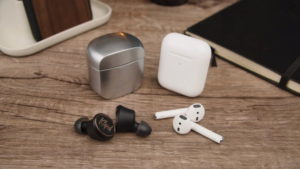For people who are interested in the world of audio and voice, you could see three general observations from CES 2020. 1. Hearables 2. Voice in the car 3. Voice in the home… and just about every other device you can think of.
First, hearables. Apple, who initially popularized the idea of wearing earbuds, has led the way again with their wireless headphone, Airpods. Most people are familiar with this product (along with the new Pro version), but at CES it was clear competitors are not going to let Apple be the only company to take a seat at the table. Two notable companies at CES this year releasing new products were Nuheara with the IQbuds MAX, and Klipsch with the T10 and T5. For Nuheara, a company known for innovation in the hearable market, their key differentiator with the IQbuds Max is not just noise cancellation, but a true personalization of audio to the consumers’ hearing. With Klipsch, they are boasting the ability to have noise cancellation but are also pushing innovative design and experience with the world’s smallest and lightest hearables. To be clear, these are just two of the numerous and ever-growing competitors involved in the hearable space. With so much attention going to hearables, it is important to note the opportunity and potential for a “hearable app” ecosystem to evolve in the future.

Next up, Voice in the car. If you were at CES and took any time to check out the Alexa Auto booth, you were likely to be met with swarms of people looking at the newest partnerships alongside Amazon. And yes, for everyone that was worried, Lamborghini did announce Alexa in The Huracán EVO family in 2020. But aside from this, it was hard to go to an auto booth and not have them feature a voice assistant of some sort, or have the ability to choose between your assistant of choice. With cars being a natural extension of the experiences we have with voice in our homes, seeing the infrastructure continue to expand and mature is compelling for any companies currently building or interested in building experiences or utilities that leverage voice in the car.
Finally whether it was Google Assistant, Alexa, or a self built technology, voice accessibility and voice assistants in consumer devices have gone from “nice to have” to a “must have”. Companies like Amazon have made it clear they have a strategy to voice enable everything around us, and there were no shortage of these devices at CES. If you took a walk through the Alexa or Google Assistant sections, you could see many of the devices they have announced in past events in the battle to connect your home. Everything from microwaves and coffee machines to your wifi routers now has voice enabled technology. In the home, common things that are now voice enabled are mirrors, thermostats, doorbells, lights, shades, showers, toilets, toothbrushes, diffusers, mattresses, and the list goes on!
The main takeaway is this simple fact: Voice is continuing to be introduced and pushed in all of the products around us. The question is what opportunities and disruption come along with a platform shift like the one we are seeing with voice? For that, only time will tell.
Photo Credit in Order: Jonas Leupe, Dan Baker / Digital Trends